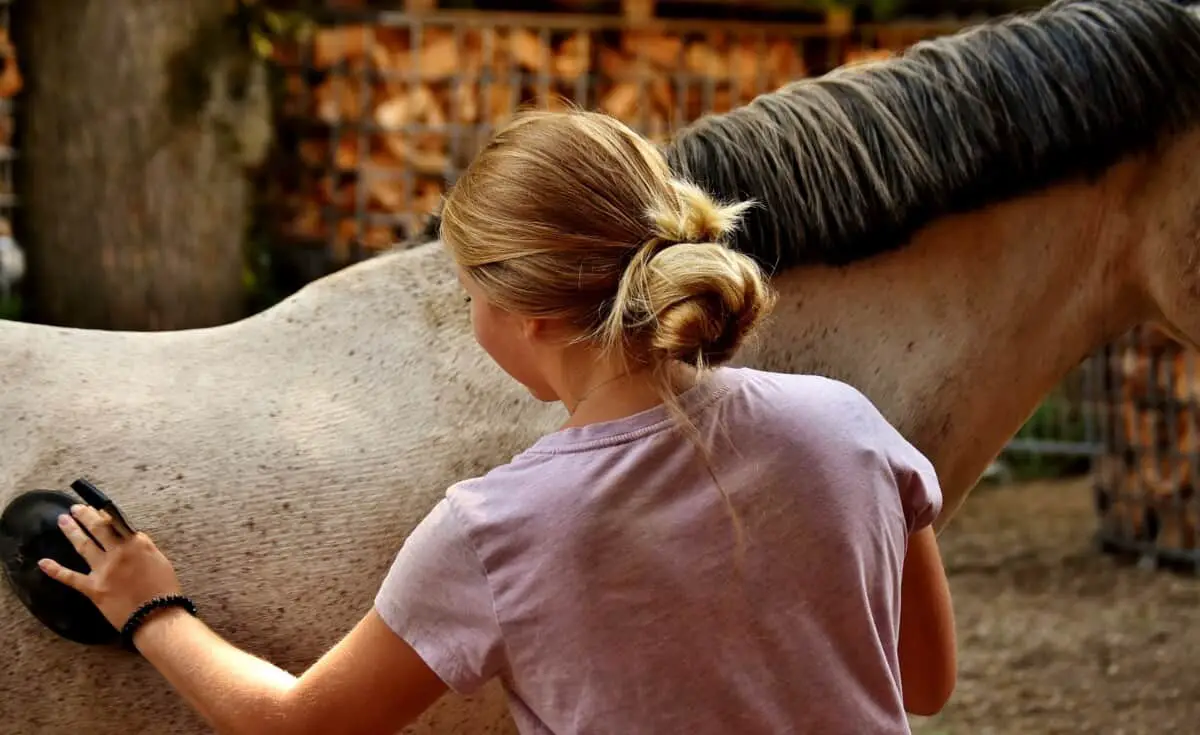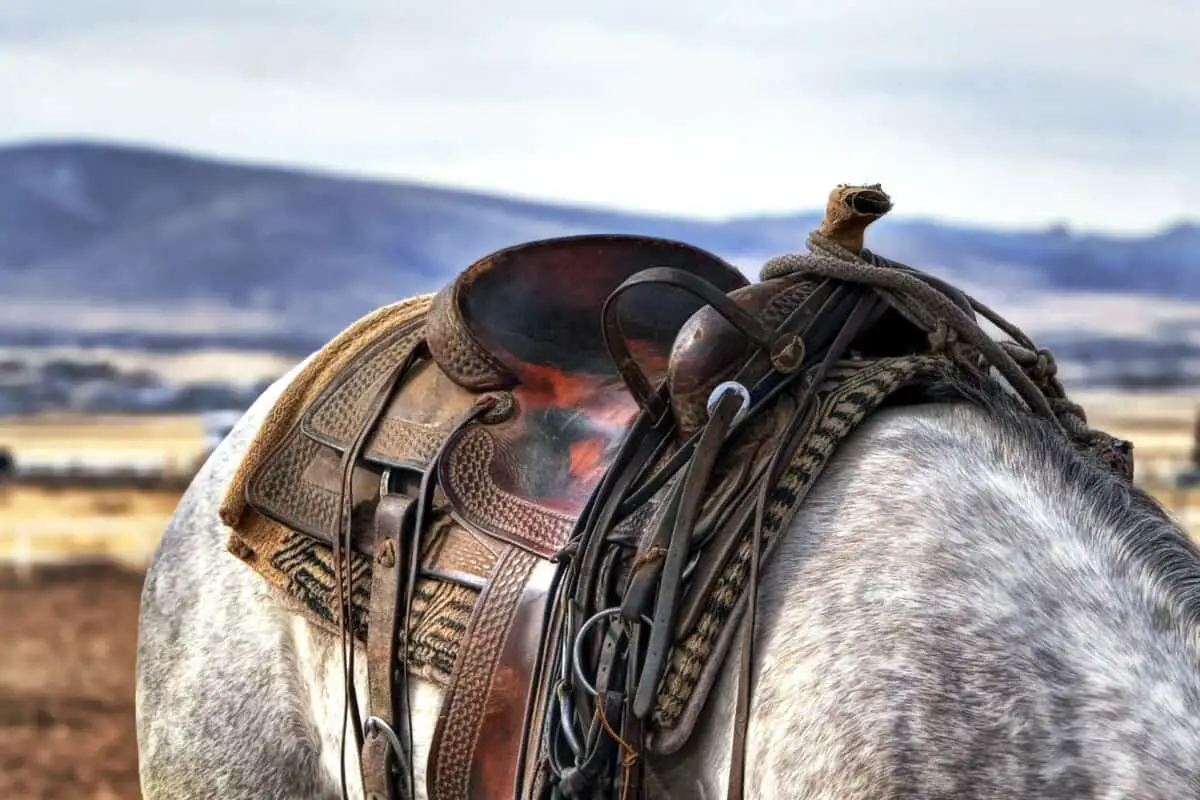Skip To Section
The good news is that the basics of saddling a horse are the same whether you ride your horse English or Western style. The main aim of saddling your horse is to ensure that both the horse and the rider are safe and comfortable.
Saddling a horse might seem complicated at first, but once you get the hang of it, you will be able to do it quickly. Here is a detailed guide on how to saddle a horse the right way.

Step 1: Brush Your Horse
The first step is to ensure that the horse is clean because any grit on the horse can cause chaffing just under where the saddle or girth sits.
Gently brush the horse so that all the hair lies flat.
Inspect the girth area for dirt and grit. Sponge or gently brush away mud and dirt with a curry comb. Grit on the girth area can cause painful galls or irritation for the horse and cause it to misbehave.
The traditional way to saddle a horse is to begin on the horse’s left side. However, experienced riders are capable of saddling a horse from the right side or offside as well, as it might be necessary to do so at times.
Step 2: Position The Saddle Pad Or Blanket
If you use a Western saddle pad, it will not need folding because they are usually folded in half. The fold goes to the front when placed on the horse.
English saddle pads are usually shaped so that they fit neatly under the saddle. They can be left as-is on the horse’s back, or they might have to be tied down to keep it in place while riding. Some English saddle pads have hook and loop fastener tabs that attach to a D-ring on the saddle.
Gently put the saddle pad on the horse’s back (whether it is an English or Western saddle pad). The positioning of the saddle pad on the horse is very critical. Place it forward, over the withers, and slide it back into place. By doing this, you ensure the hair on the horse’s back lies comfortably flat under the pad and saddle. The saddle pad or blanket must be equal on the horse’s left side as well as on the right side.
Check for folds, wrinkles, or rolls and iron them out with the palms of your hands.
Step 3: Lift The Saddle On
Here, there is a bit of difference between an English saddle and a Western saddle.
The stirrups of an English saddle must be run up the leathers so that they don’t swing around and hit your horse (that could cause your horse to spook). It also prevents the stirrups from getting caught anywhere.
Western saddles don’t have leather. In the case of Western saddles, the offside stirrup must be hooked over the saddle horn or folded over the seat.
If a girth or cinch are attached, they should be folded back over the saddle seat.
English saddles give riders the choice of removing the girth after every ride. If you do this, make sure you buckle up both sides when you saddle up.
Lift the saddle high so that it does not hit the horse or displace the pad.
The right way to place a saddle is slightly forward, and then to settle it back.
Saddles are pretty heavy, and placing them suddenly or heavily on your horse’s back could spook it or resent being saddled. So, ensure you put it gently on your horse’s back.
Step 4: Smooth Out Wrinkles And Folds
Walk around to the offside and bring down the stirrup of a Western saddle. Ensure there are no creases, wrinkles, or folds beneath the saddle on either side. If the cinch is not attached to the offside, tie/buckle it. Once again, check that the saddle pad or blanket is smooth and lying flat and that the horse’s hair is lying in the natural direction it grows.
Step 5: Check Both Sides Of The Saddle
Both sides of the saddle must sit uniformly on the horse’s back.
Move to the near side and reach beneath the horse for the free end of the girth or cinch.
Step 6: Buckle Up The Girth Or Cinch Straps
Buckle the girth or tie the cinch loosely. Tighten the girth or cinch gently and in small increments. If this is not done lightly, your horse could panic, kick, or bite. Some horses have the habit of bloating themselves because they anticipate discomfort. If your horse does this, get it to step forward, wait a few moments for it to exhale, and then tighten the girth gently.
The girth should be tightened only just enough to hold the saddle in place. Many riders make the mistake of tightening the girth too much because they believe they will be more secure when they ride. However, this does not help and could lead to injuries or breathing difficulties. You should be able to slide your fingers between the horse and the girth or cinch.
If your saddle pads have tabs at the front, then loop them through the D-rings that are placed at the front of the saddle – or simply tie them.
Step 7: Allow The Saddle To Settle And Remove Wrinkles
Ensure there are no wrinkles on your horse’s skin just under the girth.
Stand in front of your horse and gently lift a leg by holding low on the canon or pastern, and give it a forward stretch. Do this for both the front legs. This sometimes loosens the girth. Check the girth once again before you mount the horse and once more after a few minutes of riding.

How Long Does It Take To Saddle A Horse?
It usually takes around ten minutes to saddle a horse. But this might vary depending on the skill of the rider, the type of saddle used, and how amicable the horse is. Some skilled riders can saddle a horse and get all the equipment on in less than ten minutes.
How Do You Saddle A Horse For The First Time?
You can make saddling a horse a positive experience for your horse and yourself by following some simple rules.
Stay Calm
Every horse is different. Your horse could accept a saddle gracefully, or it could buck – or you might simply not be able to control it. You could work in a round pen to keep it safe. Ensure no tools are lying around.
Introduce The Pad
Introduce the pad gently. Allow your horse to smell and see it. Start by putting it on your horse’s neck and then slide it backward gently. Flop it around right to your horse’s butt, so it knows that the pad is not going to hurt. Finally, put it in position.
Introduce The Saddle
Once your horse is comfortable with the pad, introduce the saddle to your horse. Allow your horse to see it and smell it. Make sure your horse is paying attention. Ensure the outside stirrup is resting on the saddle horn.
Hold the lead rope in your left hand and the saddle in your right. Move forward and put the saddle on your horse. Make sure you have the lead rope secure and that you won’t get tangled in it.
Don’t expect your horse to stand perfectly still and accept the saddle. Adjust the saddle well. Move around to the opposite side of your horse and lower the stirrup from the saddle horn. Don’t allow the stirrup or any other part of the saddle to bang against the horse’s side until you have secured it properly.
At all times, ensure your horse knows who you are. Always move slowly, but don’t be sneaky as that could spook your horse. If you will be using a breast collar, this is the order it must be placed:
- Girth
- Back cinch
- Breast collar
You will need to reassure your horse a lot when you tighten the saddle, as this will cause some pressure. Always be prepared for the worst.
Secure The Girth
Gently slide your hand down your horse’s leg to where the girth goes, so that it can feel your presence on that part of its body. Reach under slowly and grab the girth. Don’t make any quick or jerking movements. As you tighten the girth snuggly, your horse might want to move around, and you will have to move with it.
Secure The Back Cinch
The back cinch is there to hold your saddle securely, so ensure it is snug but not very loose or very tight. The back cinch can cause some discomfort for your horse at first, so ensure you apply it carefully and slowly.
Secure The Breast Collar
Take your time with the breast collar. Your horse must remain calm while you still hold on to the lead rope safely. Once the breast collar is secure, you can walk your horse to the center of the round pen.
Your horse might be surprised by how the saddle feels when it moves. You can assure your horse by turning to face it and watch it as you walk it forward.
Conclusion
It takes little time to learn how to put a saddle on a horse, and once you get it right, you will master the process quickly. The critical thing to remember is that your horse and you (the rider) must be comfortable and safe at all times.
